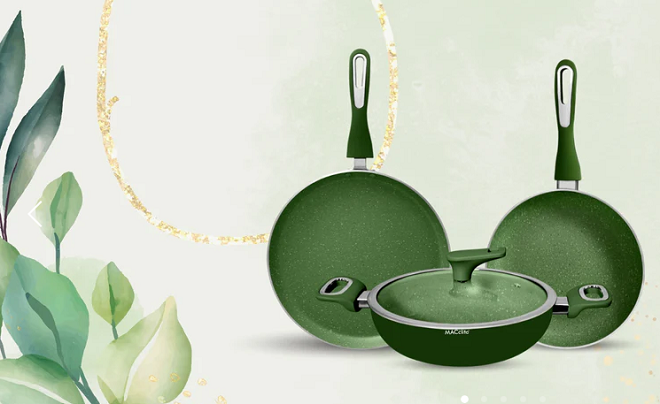
Non Non Stick Pans: A Guide to Healthy Cooking
Are Non-Stick Pans Unsafe? Before delving into non-stick alternatives, it's crucial to address the safety concerns associated with traditional non-stick pans. While older models contained PFOA, a synthetic chemical linked to health issues, modern non-stick cookware is free of PFOA, as confirmed by the American Cancer Society. Despite this, exploring alternative options is prudent. Let's explore three popular alternatives to traditional non-stick cookware.
Table of Contents:
-
Introduction
- Are Non-Stick Pans Unsafe?
-
Alternatives to Non-Stick Cookware
- Die Cast Cookware
- Cast Iron Cookware
- Copper Cookware (An Eco-Friendly Hydration Solution)
-
Die Cast Cookware: A Safe and Stylish Option
- Composition and Features
- Maintenance Tips
- Explore Our Die Cast Cookware Range
-
Cast Iron Cookware: Durability and Versatility
- Composition and Benefits
- Considerations Before Purchase
- Explore Pre Seasoned Cast Iron Cookware
-
Copper Bottle: An Eco-Friendly Hydration Solution
- Composition and Benefits
- Tips for Copper Cooking
- Best Copper Cookware Options
-
Conclusion
- Choosing the Right Alternative for Your Cooking Style
- Recommendations for a Balanced Kitchen
Alternatives to Non-Stick Cookware:
Alternative 1: Die Cast Cookware
Composition and Features: Die Cast cookware, featuring a pure aluminum base with a thin ceramic layer, provides excellent heat conductivity and a non-stick surface. The ceramic gel, made from silicone and oxygen, ensures a stick-resistant cooking experience. The non-porous surface makes it ideal for handling acidic foods without absorption, and it's free from toxic chemicals like PFOA, PTFE, Lead, Cadmium, PFAS, synthetic coatings, and heavy metals.
Maintenance Tips: While Die Cast cookware offers a safe and efficient cooking surface, proper care is essential. Avoiding scratches by mindful usage, cleaning, and storage is crucial for prolonging the life of these pans.
Alternative 2: Cast Iron Cookware
Composition and Benefits: Enameled cast iron pans, featuring a regular cast iron base with an enamel coating, offer a non-stick experience without the need for frequent replacements. The toxin-free enamel coating eliminates seasoning hassles, rusting, and promotes exceptional heat retention. The pans are chip and crack-resistant, making them perfect for slow-cooked dishes.
Considerations Before Purchase: While enameled cast iron is durable and versatile, it's essential to note its weight and slower heating time compared to non-stick pans.
Tips for Non-Stick Cooking with Cast Iron: Although not an obvious non-stick choice, cast iron can serve as a viable alternative. Preheating the pan, using the right amount of fats, and practicing proper frying techniques enhance its non-stick properties. Seasoning the pan is also recommended for optimal results.
Alternative 3: Copper Bottle - An Eco-Friendly Hydration Solution
Composition and Features: Crafted with meticulous attention to detail, copper cookware typically features a thin layer of copper on the exterior, ensuring rapid and even heat distribution. Some copper cookware may also include a stainless steel or tin lining to enhance durability and prevent any reactivity with certain foods.
Considerations Before Purchase: One of the standout features of copper cookware is its exceptional heat conductivity. This property allows for quick response to temperature changes, ensuring that your dishes are cooked to perfection. From delicate sauces to searing meats, copper cookware excels in providing precise control over the cooking process.
Tips for Non-Stick Cooking with Copper Cookware: While copper cookware is celebrated for its performance, proper maintenance is key to preserving its beauty and functionality. Regular polishing helps retain the shine, and hand washing with mild detergent is recommended to prevent damage to the delicate lining.
Conclusion:
Choosing the Right Alternative for Your Cooking Style
- For a non-stick experience closest to traditional pans, go for Die Cast Cookware
- If durability and versatility are priorities, and you don't mind the extra cleaning effort, stainless steel is an excellent choice
- Enameled cast iron strikes a balance between durability and versatility, though it comes at a higher cost
Consider mixing and matching these alternatives based on your cooking needs. For instance, reserve a Die Cast pan for busy days or delicate foods, and use enameled cast iron or stainless steel for other cooking tasks.
Happy and healthy cooking! 😄🍛✨
Featured collection
-
Original price - Original priceOriginal price Rs. 19.99Rs. 19.99-Current price Rs. 19.99
Product title
Original price - Original priceOriginal price Rs. 19.99Rs. 19.99-Current price Rs. 19.99 -
Original price - Original priceOriginal price Rs. 19.99Rs. 19.99-Current price Rs. 19.99
Product title
Original price - Original priceOriginal price Rs. 19.99Rs. 19.99-Current price Rs. 19.99 -
Original price - Original priceOriginal price Rs. 19.99Rs. 19.99-Current price Rs. 19.99
Product title
Original price - Original priceOriginal price Rs. 19.99Rs. 19.99-Current price Rs. 19.99 -
Original price - Original priceOriginal price Rs. 19.99Rs. 19.99-Current price Rs. 19.99
Product title
Original price - Original priceOriginal price Rs. 19.99Rs. 19.99-Current price Rs. 19.99 -
Original price - Original priceOriginal price Rs. 19.99Rs. 19.99-Current price Rs. 19.99
Product title
Original price - Original priceOriginal price Rs. 19.99Rs. 19.99-Current price Rs. 19.99
Blog posts
-
-

What is Karahi or Kadahi? Exploring Its Best Use in 2024 | Non Stick
The kadai or karahi holds a special place, when it comes to Indian cooking,choose MACclite kadai cookware for a healthier and more enjoyable cooking experience.Read now -

Best Tawa for Roti 2024 - Guide to Choosing the Best Iron Tawa for Your Family
The roti tawa is the right tool to achieve the ideal texture and taste. Finding the perfect roti tawa for your family can be both rewarding and challenging in 2024 due to the many options available.Read now


